Assessing the Impacts of Urban Expansion on Habitat Quality by Combining the Concepts of Land Use, Landscape, and Habitat in Two Urban Agglomerations in China
Abstract
1. Introduction
2. Study Area and Data Sources
2.1. Study Area
2.2. Data Sources
3. Methodological Approach
3.1. Land-Use Change Analysis
3.2. Habitat Quality Analysis
3.3. Macroeconomic Drivers Analysis
4. Results
4.1. Habitat Quality Analysis
4.2. Changes in Habitat Quality Induced by Land-Use Changes
4.3. Changes in Habitat Quality from the Perspective of Landscape Metrics
4.4. Macroeconomic Drivers
5. Discussion
6. Conclusions
Author Contributions
Funding
Conflicts of Interest
References
- United Nations, Department of Economic and Social Affairs, Population Division. World Urbanization Prospects; United Nations: New York, NY, USA, 2018. [Google Scholar]
- United Nations Human Settlements Programme. Planning Sustainable Cities; UN-Habitat: Nairobi, Kenya, 2009. [Google Scholar]
- Tan, Z.-B. Urban Planning; Tsinghua University Press: Beijing, China, 2005. [Google Scholar]
- Huang, J.; Lin, T.; Zhang, G.-B.; Li, X.-H. Comparative Analysis of the Urbanization Dynamic Characteristics of the Three Major Urban Agglomerations in China. China Popul. Resour. Environ. 2014, 24, 37–44. [Google Scholar] [CrossRef]
- Gottmann, J. Megalopolis or the urbanization of the northeastern Seaboard. J. Econ. Geogr. 1957, 33, 189–220. [Google Scholar] [CrossRef]
- Ouyang, Z.-Y.; Zheng, H. Ecological mechanisms of ecosystem services. Acta Ecol. Sin. 2009, 29, 6183–6188. [Google Scholar]
- Kremen, C.; Williams, N.M.; Aizen, M.A.; Gemmill-Herren, B.; LeBuhn, G.; Minckley, R.; Packer, L.; Potts, S.G.; Roulston, T.; Steffan-Dewenter, I.; et al. Pollination and other ecosystem services produced by mobile organisms: A conceptual framework for the effects of land-use change. Ecol. Lett. 2007, 10, 299–314. [Google Scholar] [CrossRef] [PubMed]
- Tscharntke, T.; Klein, A.M.; Kruess, A.; Steffan-Dewenter, I.; Thies, C. Landscape perspectives on agricultural intensification and biodiversity-ecosystem service management. Ecol. Lett. 2005, 8, 857–874. [Google Scholar] [CrossRef]
- Quétier, F.; Lavorel, S.; Thuiller, W.; Davies, I. Plant-trait-based modeling assessment of ecosystem-service sensitivity to land-use change. Ecol. Appl. 2007, 17, 2377–2386. [Google Scholar]
- Díaz, S.; Lavorel, S.; de Bello, F.; Quétier, F.; Grigulis, K.; Robson, T.M. Incorporating plant functional diversity effects in ecosystem service assessment. Proc. Natl. Acad. Sci. USA 2007, 104, 20684–20689. [Google Scholar] [CrossRef]
- Ding, Y.-K.; Shan, B.-Q.; Zhao, Y. Assessment of River Habitat Quality in the Hai River Basin, Northern China. Int. J. Environ. Res. Public Health 2015, 12, 11699–11717. [Google Scholar] [CrossRef]
- Le Maitre, D.-C.; Milton, S.-J.; Jarmain, C.; Colvin, C.-A.; Saayman, I.; Vlok, J.-H.-J. Linking ecosystem services and water resources: Landscape-scale hydrology of the Little Karoo. Front. Ecol. Environ. 2007, 5, 261–270. [Google Scholar] [CrossRef]
- Tallis, H.T.; Ricketts, T.; Nelson, E.; Ennaanay, D.; Wolny, S.; Olwero, N.; Vigerstol, K.; Pennington, D.; Mendoza, G.; Aukema, J.; et al. InVEST 1.004 Beta User’s Guide. The Natural Capital Project; Stanford University: Stanford, CA, USA, 2010. [Google Scholar]
- Nelson, E.; Mendoza, G.; Regetz, J.; Polasky, S.; Tallis, H.; Cameron, D.R.; Chan, K.M.A.; Daily, G.C.; Goldstein, J.; Kareiva, P.M.; et al. Modeling multiple ecosystem services, biodiversity conservation, commodity production, and tradeoffs at landscape scales. Front. Ecol. Environ. 2009, 7, 4–11. [Google Scholar] [CrossRef]
- Li, R. Research on the ecological benefits of soil conservation of Yulin City based on InVEST model. Arid. Zone Res. 2015, 32, 882–889. [Google Scholar]
- Chen, S.-S.; Liu, K.; Li, T.; Yuan, J.-G. Evaluation of ecological service function of soil conservation in Shangluo City based on InVEST model. Acta Pedol. 2016, 53, 800–807. [Google Scholar]
- Huang, C.-H.; Yang, J.; Zhang, W.-J. The application of forest inventory data in an ecosystem service evaluation model: InVEST. For. Resour. Manag. 2014, 5, 126–131. [Google Scholar]
- He, T.; Sun, Y.-J. Dynamic monitoring of forest carbon stocks based on the InVEST model. J. Zhejiang AF Univ. 2016, 33, 377–383. [Google Scholar]
- Chen, Y.; Qiao, F.; Jiang, L. Effects of land use pattern change on regional scale habitat quality based on InVEST model—A case study in Beijing. Acta Sci. Nat. Univ. Pekin. 2016, 52, 553–562. [Google Scholar]
- Liu, Z.-F.; Tang, L.-N.; Qiu, Q.-Y.; Xiao, L.-S.; Xu, T.; Yang, L. Temporal and spatial changes in habitat quality based on land-use change in Fujian Province. Acta Ecol. Sin. 2017, 37, 4538–4548. [Google Scholar]
- Braat, L.; Brink, P.T. The Cost of Policy Inaction (COPI). The Case of not Meeting the 2010 Biodiversity Target; IEEP: The Enveco Meeting, Brussels, Belgium, 2008 17 June. [Google Scholar]
- Mansoor, D.L.; Marty, D.M.; Eric, C.C.; Lanier, L.N. Quantifying and mapping multiple ecosystem services change in West Africa. Agric. Ecosyst. Environ. 2013, 165, 6–18. [Google Scholar]
- Stephen, P.; Erik, N.; Derric, P.; Kris, A.J. The Impact of Land-Use Change on Ecosystem Services, Biodiversity and Returns to Landowners: A Case Study in the State of Minnesota. Environ. Resour. Econ. 2011, 48, 219–242. [Google Scholar]
- Han, J.-R. The Impact of Urban Sprawl on Carbon Stocks Based on the InVEST Model. Master’s Thesis, Northeast Normal University, Jilin, China, 2013. [Google Scholar]
- He, C.; Zhang, D.; Huang, Q.; Zhao, Y. Assessing the potential impacts of urban expansion on regional carbon storage by linking the LUSD-urban and InVEST models. Environ. Model. Softw. 2016, 75, 44–58. [Google Scholar] [CrossRef]
- Jiang, W.; Deng, Y.; Tang, Z.; Lei, X.; Chen, Z. Modelling the potential impacts of urban ecosystem changes on carbon storage under different scenarios by linking the CLUE-S and the InVEST models. Ecol. Model. 2017, 345, 30–40. [Google Scholar] [CrossRef]
- Wang, M.; Ruan, J.-J.; Yao, J.; Sha, C.-Y.; Wang, Q. Study on soil conservation service of ecosystem based on InVEST model-A case study of Ningde City, Fujian Province. Res. Soil. Water. Conserv. 2014, 21, 184–189. [Google Scholar]
- Wu, J.-S.; Cao, Q.-W.; Shi, S.-Q.; Huang, X.-L.; Lu, Z.-Q. Spatio-temporal variability of habitat quality in Beijing-Tianjin-Hebei Area based on land use change. Chin. J. Appl. Ecol. 2015, 26, 3457–3466. [Google Scholar]
- Sang, Y.-F.; Wang, Z.-G.; Li, Z.-L.; Liu, C.-M.; Liu, X.-J. Investigation into the daily precipitation variability in the Yangtze River Delta, China. Hydrol. Process. 2013, 27, 175–185. [Google Scholar] [CrossRef]
- Jiang, W.-H.; Hu, Y.-L. The World’s Sixth Mega-City Group: The Rising of the Yangtze River Delta City Group; Shanghai Academy of Social Sciences Press: Shanghai, China, 2010. [Google Scholar]
- Liu, G.-L.; Zhang, L.-C.; Zhang, Q. Spaial and temporal dynamics of land use and its influence on ecosystem service value in Yangtze River Delta. Acta Ecol. Sin. 2014, 34, 3311–3319. [Google Scholar]
- Liu, X.; Ding, Z.-C.; Yang, Y.-X. Strategies Towards a Metropolitan Area with Strong MICE Industry in Minnan Golden Triangle. J. Xiamen Univ. Technol. 2016, 24, 34–40. [Google Scholar]
- Zhu, L.-C.; Wang, H.-W.; Tang, L.-N. Importance evaluation and spatial distribution analysis of ecosystem services in Min triangle are. Acta Ecol. Sin. 2018, 38, 7254–7268. [Google Scholar]
- Hall, L.S.; Krausman, P.R.; Morrison, M.L. The habitat concept and a plea for standard terminology. Wildl. Soc. Bull. 1997, 25, 173–182. [Google Scholar]
- Nelleman, C.; Kullered, L.; Vistnes, I.; Forbes, B.; Foresman, T.; Husby, E.; Kofinas, G.; Kaltenborn, B.; Rouaud, J.; Magomedova, M.; et al. GLOBIO, Global Methodology for Mapping Human Impacts on the Biosphere: The Arctic 2050 Scenario and Global Application; United Nations Environment Programme: Nairobi, Kenya, 2001. [Google Scholar]
- Mckinney, M.L. Urbanization, biodiversity, and conservation. BioScience 2002, 52, 883–890. [Google Scholar] [CrossRef]
- Forman, R. Road Ecology: Science and Solutions; Island Press: New York, NY, USA, 2003. [Google Scholar]
- Bao, Y.-B.; Liu, K.; Li, T.; Hu, S. Effects of Land Use Change on Habitat Based on InVEST Model-Taking Yellow River Wetland Nature Reserve in Shaanxi Province as an Example. Arid. Zone Res. 2015, 32, 622–629. [Google Scholar]
- Wang, L.-Y. Scenario Simulation for Urban Land Growth Under the Constraint of Ecological Space Quality-A Case of Modified SLEUTH Model. Master’s Thesis, Nanjing University, Nanjing, China, 2016. [Google Scholar]
- Zhong, L.-N.; Wang, J. Evaluation on effect of land consolidation on habitat quality based on InVEST model. Trans. Chin. Soc. Agric. Eng. 2017, 33, 250–255. [Google Scholar]
- Rong, Y.-J.; Zhang, H.; Wang, Y.-S. Assessment on Land Use and Biodiversity in Nanjing City Based on Logistic-CA-Markov and InVEST Model. Res. Soil Water. Conserv. 2016, 23, 82–89. [Google Scholar]
- Wu, J.-Q. Integrated Assessment of Ecosystem in Hainan Bamen Bay Based on CA-Markov and InVEST Models. Master’s Thesis, Hainan University, Hainan, China, 2012. [Google Scholar]
- Pan, J.-H.; Su, Y.-C.; Huang, Y.-S.; Liu, X. Land use & landscape pattern change and its driving forces in Yumen City. Geogr. Res. 2012, 31, 1631–1639. [Google Scholar]
- Zhang, M.; Zhu, H.-Y.; He, S.-J. Landscape dynamics of medium- and small-sized cities in eastern and western China: A comparative study of pattern and driving forces. Acta Ecol. Sin. 2013, 33, 275–285. [Google Scholar]
- Hepcan, S. Analyzing the pattern and connectivity of urban green spaces: A case study of Izmir, Turkey. Urban Ecosyst. 2013, 16, 279–293. [Google Scholar] [CrossRef]
- Hu, D.-X.; Tang, L.-N.; Qiu, Q.-Y.; Shi, L.-Y.; Shao, G.-F. Decadal temporal changes in landscapes and their driving forces for West-bank Economic Zone of Taiwan Straits. Acta Ecol. Sin. 2015, 35, 6138–6147. [Google Scholar]
- Jin, T.; An, Y.-L.; Su, X.-L.; Wu, Q.-X.; Zhang, C.; Duan, S.-Q. Research on the Topographic Differentiation of Land Use and Land Use Change in Qingshuijiang Watershed. Ecol. Econ. 2015, 31, 120–125. [Google Scholar]
- Mao, J.-X.; Li, Z.-G.; Yan, X.-P.; Zhou, S.-H. Research on the Spatio-Temporal Changes of Land Use in Relation to Topography Factors in Shenzhen City. Geogr. Geo-Inf. Sci. 2008, 24, 71–76. [Google Scholar]
- Liu, S.-L.; Yin, Y.-J.; Yang, Y.-J.; An, N.-N.; Wang, C.; Dong, S.-K. Assessment of the influences of landscape fragmentation on regional habitat quality in the Manwan Basin. Acta Ecol. Sin. 2017, 37, 619–627. [Google Scholar]
- Hu, Q.-L.; Qi, Y.-Q.; Hu, Y.-C.; Zhang, Y.-C.; Wu, C.-B.; Zhang, G.-L.; Shen, Y.-J. Changes and driving forces of land use/cover and landscape patterns in Beijng-Tianjin-Hebei region. Chin. J. Eco-Agric. 2011, 19, 1182–1189. [Google Scholar] [CrossRef]
- Wang, X.-J.; Gu, S.-Z.; Dong, D.-K.; Zhang, X.-H.; Wu, H.; Zhou, H. Study on Economic Rationality of Cultivated Land Protection in Typical Case Areas of Shandong Province. China Popul. Resour. Environ. 2011, 21, 61–65. [Google Scholar]
- Xu, P.; Wang, Y.-K.; Yang, J.-F.; Peng, Y. Identification of hotspots for biodiversity conservation in the Wenchuan earthquake-hit area. Acta Ecol. Sin. 2013, 33, 718–725. [Google Scholar]
- Bai, Y.; Ouyang, Z.-Y.; Zheng, H.; Xu, W.-H.; Jiang, B.; Fang, Y. Evaluation of the forest ecosystem services in Haihe River Basin, China. Acta Ecol. Sin. 2011, 31, 2029–2039. [Google Scholar]
- Zheng, J.-K.; Yu, X.-X.; Jia, G.-D.; Xia, B. Dynamic evolution of the ecological services value based on LUCC in Miyun Reservoir Catchment. Trans. CSAE 2010, 26, 315–320. [Google Scholar]
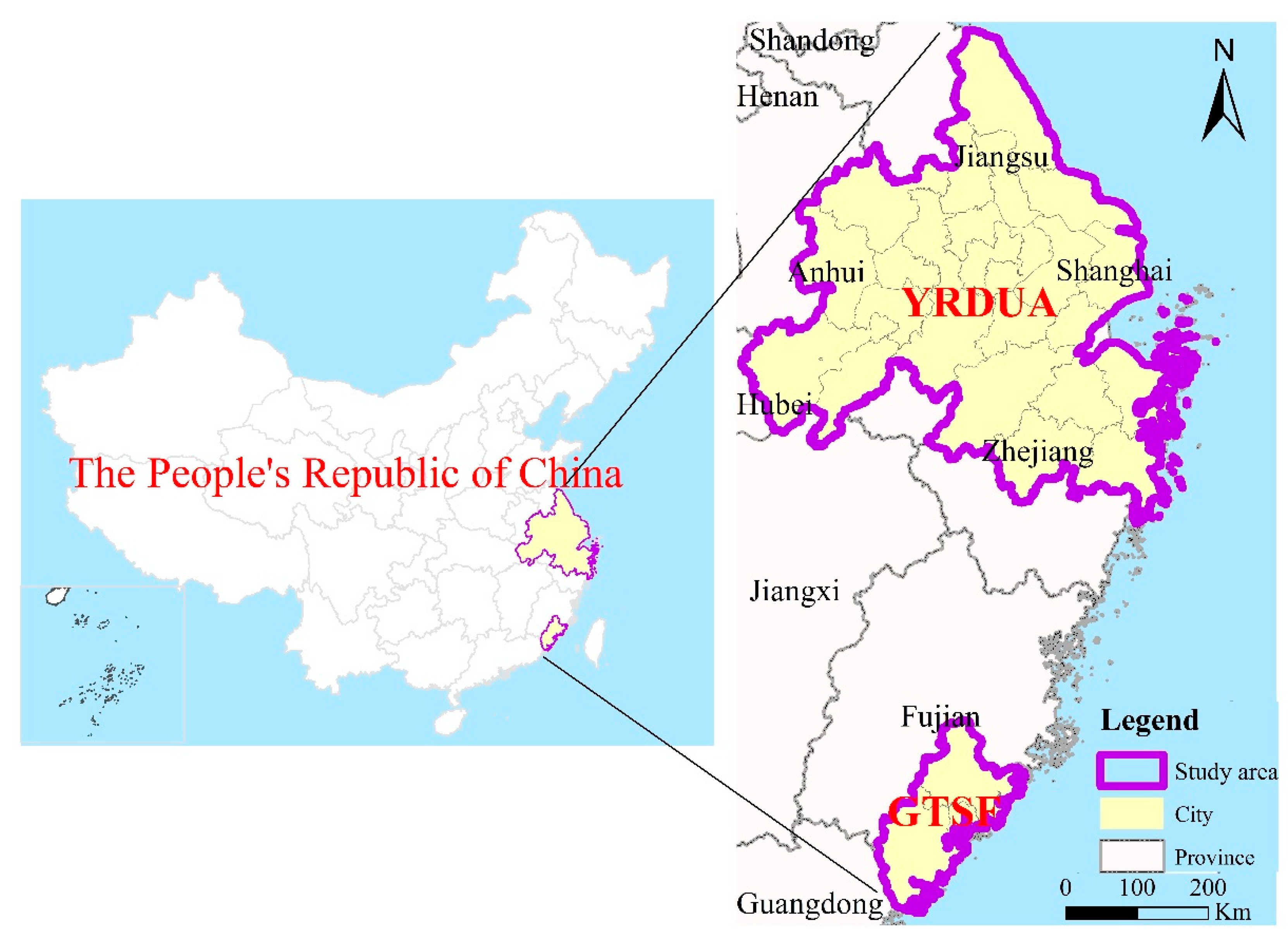
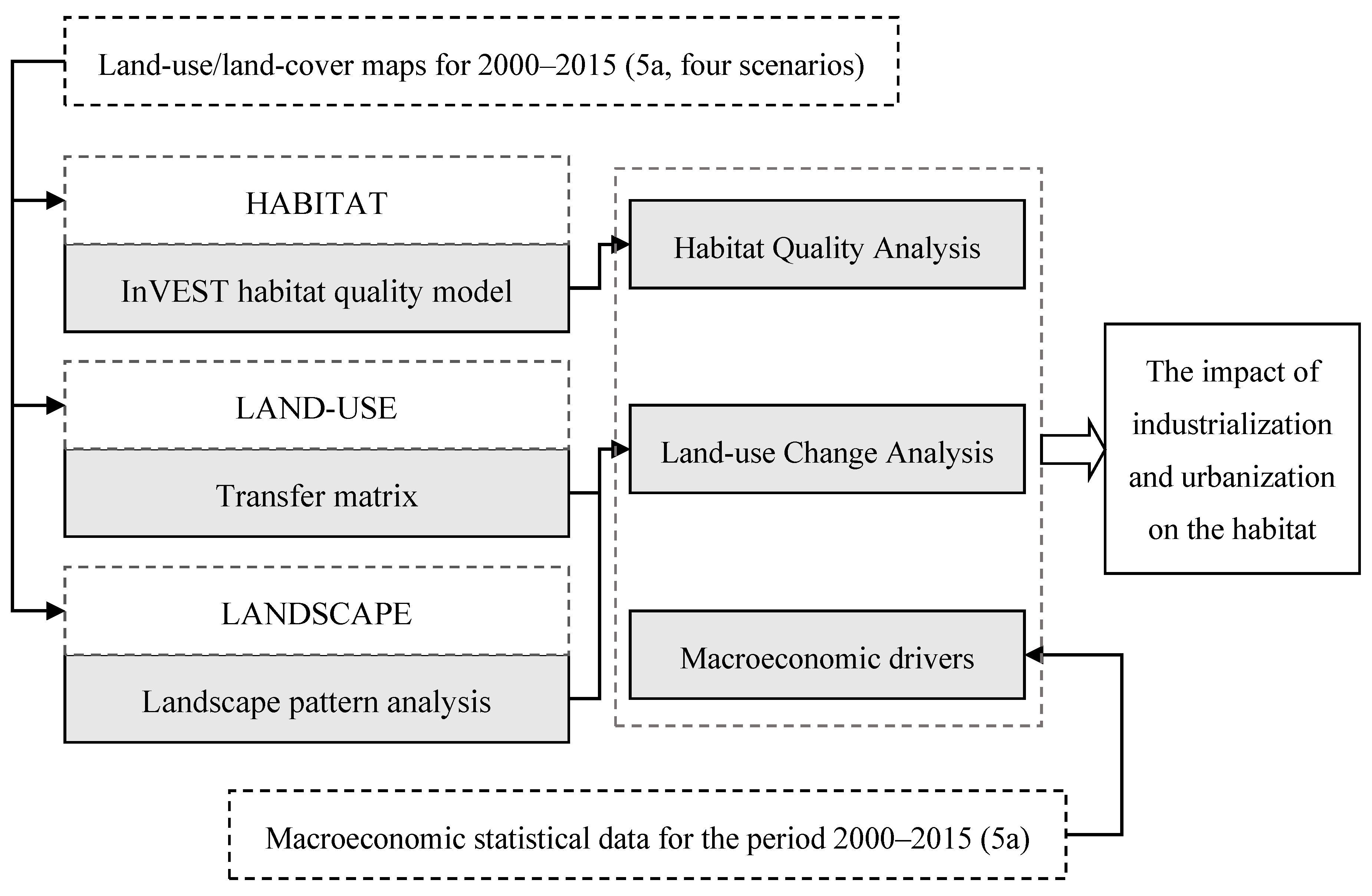
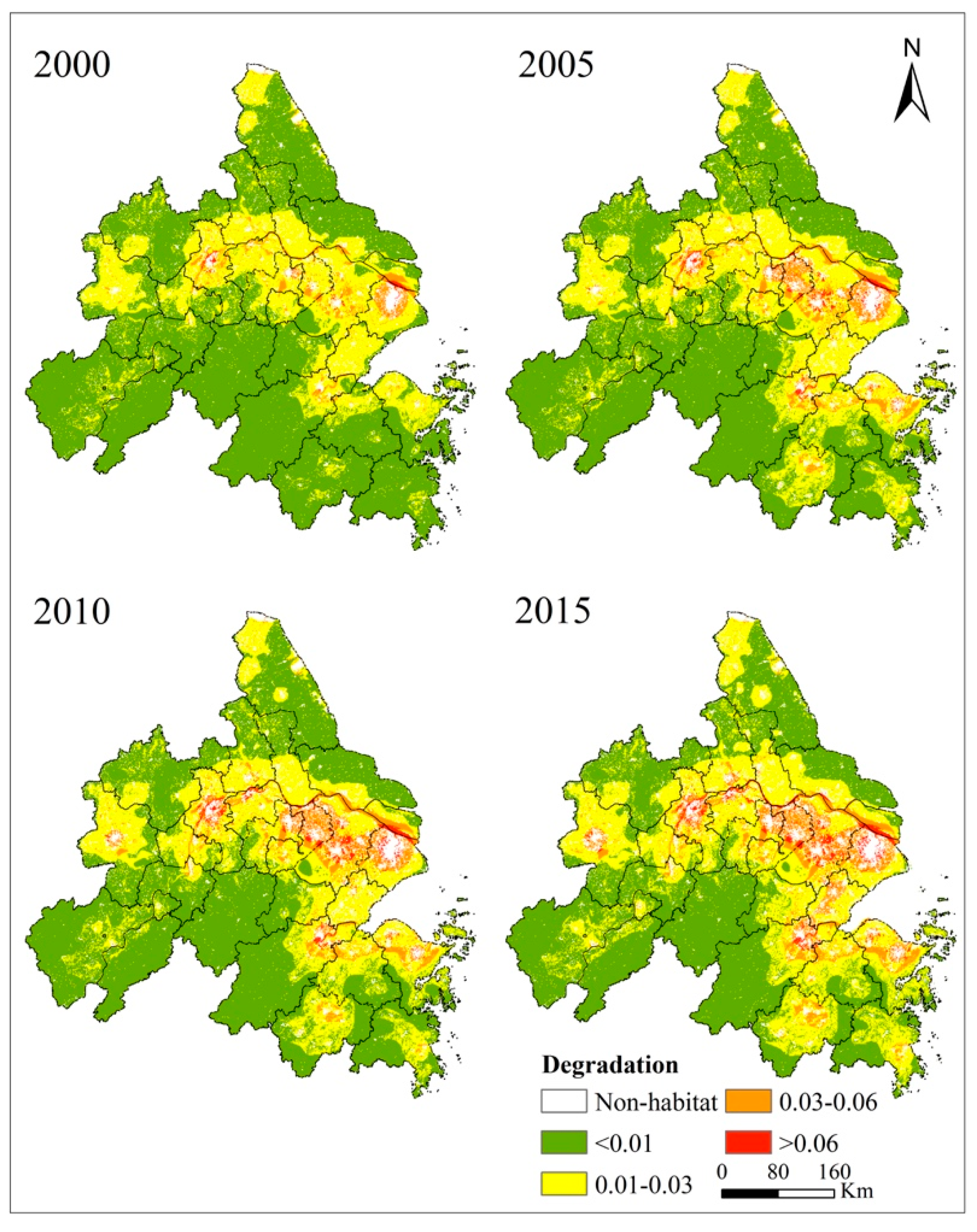


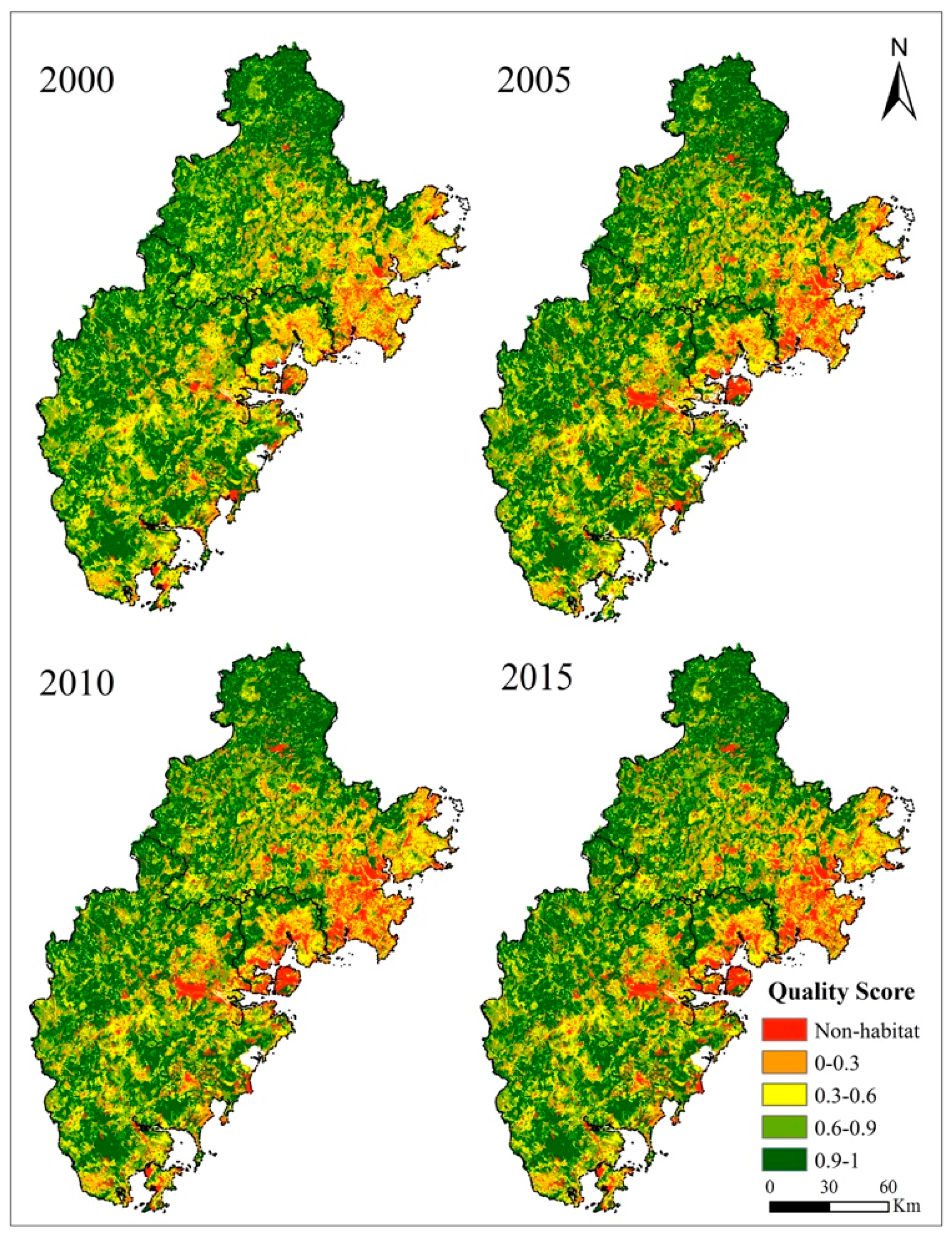
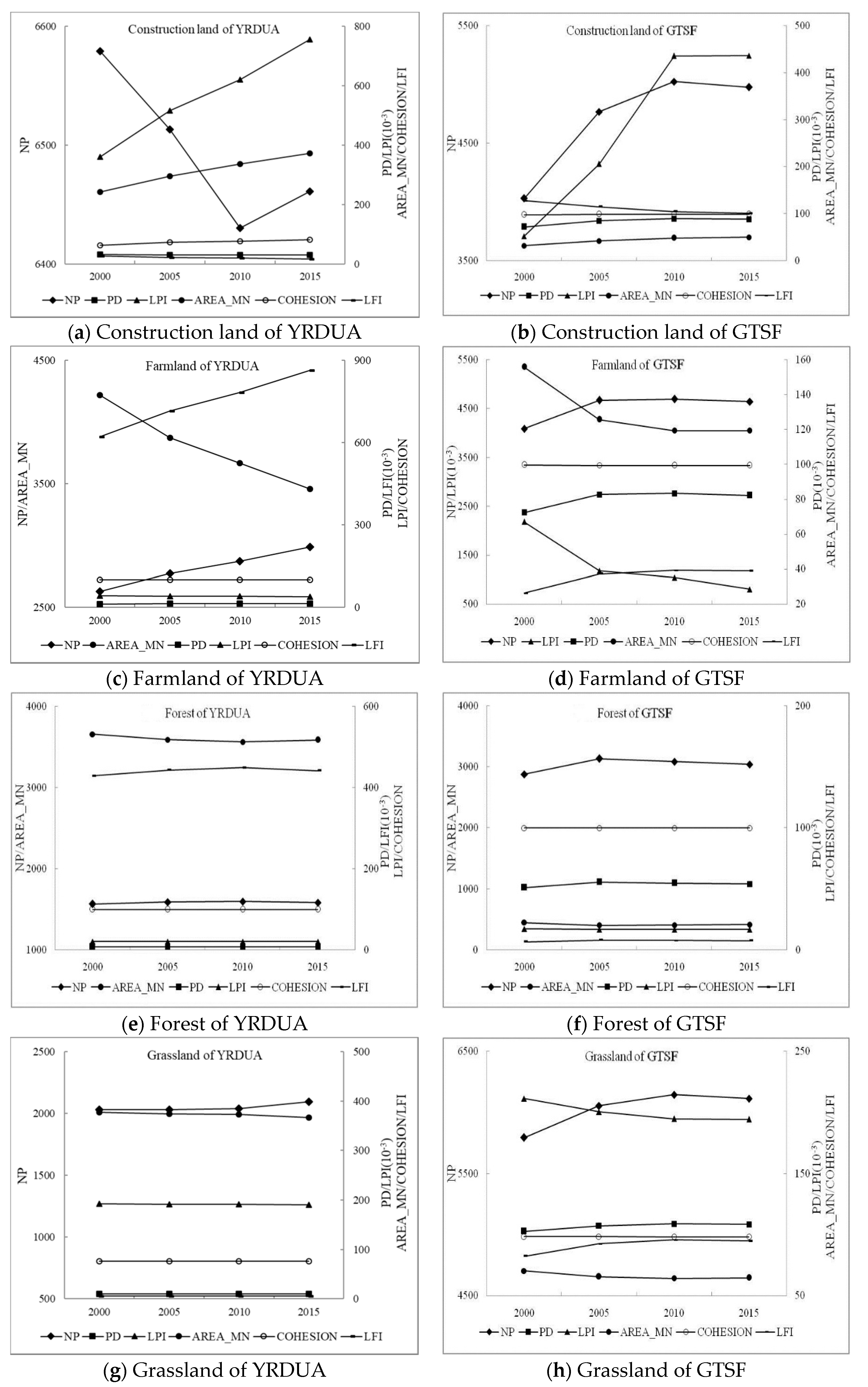
| Class1 | Class2 | Class1 | Class2 |
|---|---|---|---|
| Farmland | Paddy field | Wetland | River |
| Dryland | Lake | ||
| Forest | Woodland | Reservoir | |
| Shrubwood | Tidal flat | ||
| Sparse forest | Beach | ||
| Other woodland | Marshland | ||
| Grassland | High-coverage grassland | Sea | |
| Moderate-coverage grassland | Construction land | Urban land use | |
| Low-coverage grassland | Rural residential areas | ||
| Bare land | Bare land | Other construction land | |
| Bare rock |
| Landscape Metrics | Level | Significance |
|---|---|---|
| NP | Class/Landscape | The higher the NP, the higher the degree of fragmentation. |
| PD | Class/Landscape | The number of patches per unit area; the higher the PD, the higher the degree of fragmentation. |
| AREA_MN | Class/Landscape | Represents an average situation; patches with smaller values are more fragmented than those with larger values. |
| LPI | Class | Reflects the dominant type. In one landscape type, the ratio of the largest patch to the total landscape area. |
| COHESION | Class | The aggregation degree of a landscape type; the higher the COHESION, the higher the degree of aggregation. |
| CONTAG | Landscape | The higher the value, the better the connectivity. |
| DIVISION | Landscape | The segmentation degree of a landscape type with different patch numbers. |
| LFI | Class/Landscape | Represents the degree of fragmentation of the landscape and the complexity of landscape spatial structure. |
| Threat | Max Dist | Weight | Decay |
|---|---|---|---|
| Urban land use | 10 | 1 | Exponential |
| Rural residential areas | 5 | 0.5 | Exponential |
| Other construction land | 10 | 0.7 | Exponential |
| Land Use Type | Habitat | YRDUA | GTSF | ||||
|---|---|---|---|---|---|---|---|
| L_urbl | L_rra | L_ocl | L_urbl | L_rra | L_ocl | ||
| Paddy field | 0.5 | 0.35 | 0.35 | 0.3 | 0.3 | 0.3 | 0.3 |
| Dryland | 0.3 | 0.3 | 0.3 | 0.2 | 0.3 | 0.3 | 0.2 |
| Woodland | 1 | 0.85 | 0.75 | 0.75 | 0.9 | 0.8 | 0.8 |
| Shrub wood | 1 | 0.85 | 0.75 | 0.75 | 0.9 | 0.8 | 0.8 |
| Sparse forest | 0.8 | 0.85 | 0.75 | 0.75 | 0.9 | 0.8 | 0.8 |
| Other woodland | 0.8 | 0.5 | 0.5 | 0.5 | 0.9 | 0.8 | 0.8 |
| High-coverage grassland | 0.7 | 0.5 | 0.35 | 0.5 | 0.6 | 0.3 | 0.6 |
| Moderate-coverage grassland | 0.6 | 0.5 | 0.35 | 0.5 | 0.5 | 0.3 | 0.5 |
| Low-coverage grassland | 0.5 | 0.5 | 0.35 | 0.5 | 0.5 | 0.3 | 0.5 |
| River | 0.8 | 0.9 | 0.9 | 0.9 | 0.9 | 0.9 | 0.9 |
| Lake | 0.9 | 0.9 | 0.9 | 0.9 | 0.9 | 0.9 | 0.9 |
| Reservoir | 0.8 | 0.8 | 0.8 | 0.8 | 0.8 | 0.8 | 0.8 |
| Tidal flat | 0.7 | 0.75 | 0.8 | 0.8 | 0.8 | 0.8 | 0.6 |
| Beach | 0.7 | 0.75 | 0.8 | 0.8 | 0.8 | 0.8 | 0.6 |
| Marshland | 0.9 | 0.9 | 0.8 | 0.8 | 0.9 | 0.9 | 0.9 |
| Sea | 0 | 0 | 0 | 0 | 0 | 0 | 0 |
| Urban land use | 0 | 0 | 0 | 0 | 0 | 0 | 0 |
| Rural residential areas | 0 | 0 | 0 | 0 | 0 | 0 | 0 |
| Other construction land | 0 | 0 | 0 | 0 | 0 | 0 | 0 |
| Bare land | 0 | 0 | 0 | 0 | 0 | 0 | 0 |
| Bare rock | 0 | 0 | 0 | 0 | 0 | 0 | 0 |
| Valuation Level | Value Interval | YRDUA | GTSF | ||||||
|---|---|---|---|---|---|---|---|---|---|
| 2000 | 2005 | 2010 | 2015 | 2000 | 2005 | 2010 | 2015 | ||
| Low | [0,0.3) | 10.42% | 10.49% | 10.47% | 10.58% | 9.68% | 9.44% | 9.23% | 9.21% |
| Medium | [0.3,0.6) | 46.98% | 46.14% | 45.65% | 45.15% | 25.36% | 24.34% | 23.85% | 23.63% |
| Good | [0.6,0.9) | 15.32% | 15.74% | 16.04% | 16.19% | 22.63% | 22.96% | 23.67% | 23.88% |
| Excellent | [0.9,1] | 27.28% | 27.63% | 27.84% | 28.08% | 42.33% | 43.26% | 43.25% | 43.29% |
| Year | LULC | Bare Land | Wetland | Construction Land | Grassland | Farmland | Forest |
|---|---|---|---|---|---|---|---|
| 2000–2015 | Bare land | - | 9.12 | 2.49 | 0.00 | 0.38 | 4.90 |
| Wetland | 0.00 | - | 2.09 | 0.74 | 4.12 | 0.26 | |
| Construction land | 0.01 | 0.39 | - | 0.11 | 5.01 | 0.14 | |
| Grassland | 0.02 | 1.12 | 1.05 | - | 1.74 | 2.10 | |
| Farmland | 0.01 | 1.18 | 7.29 | 0.09 | - | 1.07 | |
| Forest | 0.01 | 0.14 | 0.86 | 0.59 | 2.44 | - | |
| 2000–2005 | Bare land | - | 0.00 | 5.24 | 0.00 | 0.49 | 0.00 |
| Wetland | 0.00 | - | 0.68 | 0.10 | 1.66 | 0.07 | |
| Construction land | 0.00 | 0.16 | - | 0.01 | 2.12 | 0.05 | |
| Grassland | 0.01 | 0.37 | 0.33 | - | 0.72 | 0.31 | |
| Farmland | 0.00 | 0.62 | 2.95 | 0.01 | - | 0.20 | |
| Forest | 0.00 | 0.05 | 0.29 | 0.07 | 0.30 | - | |
| 2005–2010 | Bare land | - | 0.11 | 0.00 | 0.00 | 0.05 | 3.13 |
| Wetland | 0.00 | - | 0.49 | 0.01 | 0.36 | 0.01 | |
| Construction land | 0.00 | 0.07 | - | 0.00 | 1.64 | 0.03 | |
| Grassland | 0.00 | 0.17 | 0.19 | - | 0.04 | 0.04 | |
| Farmland | 0.00 | 0.18 | 2.27 | 0.01 | - | 0.10 | |
| Forest | 0.00 | 0.01 | 0.19 | 0.05 | 0.11 | - | |
| 2010–2015 | Bare land | - | 8.95 | 0.16 | 0.01 | 0.35 | 1.91 |
| Wetland | 0.00 | - | 1.19 | 0.69 | 3.22 | 0.28 | |
| Construction land | 0.01 | 0.41 | - | 0.12 | 5.98 | 0.30 | |
| Grassland | 0.03 | 0.64 | 0.55 | - | 1.01 | 1.86 | |
| Farmland | 0.01 | 0.60 | 3.21 | 0.08 | - | 0.93 | |
| Forest | 0.01 | 0.11 | 0.49 | 0.49 | 2.22 | - |
| Year | LULC | Bare Land | Wetland | Construction Land | Grassland | Farmland | Forest |
|---|---|---|---|---|---|---|---|
| 2000–2015 | Bare land | - | 1.16 | 2.53 | 6.65 | 0.82 | 1.81 |
| Wetland | 0.01 | - | 10.64 | 0.32 | 1.43 | 0.96 | |
| Construction land | 0.00 | 7.05 | - | 0.33 | 2.17 | 0.77 | |
| Grassland | 0.04 | 0.14 | 3.54 | - | 0.86 | 2.99 | |
| Farmland | 0.00 | 0.70 | 12.64 | 0.61 | - | 1.63 | |
| Forest | 0.01 | 0.14 | 2.61 | 1.06 | 0.80 | - | |
| 2000–2005 | Bare land | - | 0.80 | 2.41 | 6.76 | 0.73 | 1.95 |
| Wetland | 0.02 | - | 4.23 | 0.31 | 1.14 | 0.79 | |
| Construction land | 0.00 | 0.18 | - | 0.26 | 1.92 | 0.64 | |
| Grassland | 0.04 | 0.11 | 2.50 | - | 0.52 | 1.23 | |
| Farmland | 0.00 | 0.38 | 7.69 | 0.30 | - | 0.68 | |
| Forest | 0.01 | 0.09 | 1.93 | 0.36 | 0.42 | - | |
| 2005–2010 | Bare land | - | 0.55 | 0.12 | 0.81 | 0.44 | 1.81 |
| Wetland | 0.01 | - | 4.80 | 0.25 | 0.94 | 0.65 | |
| Construction land | 0.00 | 2.10 | - | 0.31 | 1.28 | 0.55 | |
| Grassland | 0.00 | 0.06 | 1.06 | - | 0.53 | 1.69 | |
| Farmland | 0.00 | 0.39 | 4.29 | 0.34 | - | 1.06 | |
| Forest | 0.00 | 0.08 | 0.69 | 0.71 | 0.38 | - | |
| 2010–2015 | Bare land | - | 0.27 | 0.35 | 0.91 | 0.78 | 1.91 |
| Wetland | 0.01 | - | 0.84 | 0.34 | 1.39 | 0.89 | |
| Construction land | 0.00 | 0.54 | - | 0.45 | 2.32 | 1.08 | |
| Grassland | 0.01 | 0.04 | 0.31 | - | 0.84 | 2.48 | |
| Farmland | 0.00 | 0.11 | 2.05 | 0.70 | - | 1.68 | |
| Forest | 0.00 | 0.04 | 0.22 | 0.75 | 0.77 | - |
| Year | NP | PD | Area_Mn | CONTAG | Division | LFI | |
|---|---|---|---|---|---|---|---|
| GTSF | 2000 | 17892 | 0.3171 | 139.7858 | 60.0154 | 0.9700 | 127.9887 |
| 2005 | 19848 | 0.3518 | 125.2444 | 58.6348 | 0.9718 | 158.4662 | |
| 2010 | 20114 | 0.3565 | 124.4887 | 57.4540 | 0.9721 | 161.5649 | |
| 2015 | 19916 | 0.3530 | 125.6410 | 57.3507 | 0.9721 | 158.5072 | |
| YRDUA | 2000 | 15534 | 0.0741 | 1350.0772 | 42.1290 | 0.7738 | 11.5053 |
| 2005 | 15738 | 0.0750 | 1333.2444 | 40.5114 | 0.7842 | 11.8035 | |
| 2010 | 15790 | 0.0752 | 1329.1894 | 39.5566 | 0.7940 | 11.8787 | |
| 2015 | 16034 | 0.0762 | 1311.7687 | 38.5584 | 0.8016 | 12.2224 |
| Year | YRDUA | GTSF | ||||
|---|---|---|---|---|---|---|
| Primary Industry | Secondary Industry | Tertiary Industry | Primary Industry | Secondary Industry | Tertiary Industry | |
| 2000 | 8.65% | 50.41% | 40.94% | 12.02% | 50.05% | 37.92% |
| 2005 | 5.44% | 53.46% | 41.10% | 8.15% | 53.20% | 38.65% |
| 2010 | 4.21% | 51.30% | 44.50% | 5.81% | 54.16% | 40.03% |
| 2015 | 3.64% | 44.77% | 51.59% | 4.63% | 52.82% | 42.55% |
© 2020 by the authors. Licensee MDPI, Basel, Switzerland. This article is an open access article distributed under the terms and conditions of the Creative Commons Attribution (CC BY) license (http://creativecommons.org/licenses/by/4.0/).
Share and Cite
Wang, H.; Tang, L.; Qiu, Q.; Chen, H. Assessing the Impacts of Urban Expansion on Habitat Quality by Combining the Concepts of Land Use, Landscape, and Habitat in Two Urban Agglomerations in China. Sustainability 2020, 12, 4346. https://doi.org/10.3390/su12114346
Wang H, Tang L, Qiu Q, Chen H. Assessing the Impacts of Urban Expansion on Habitat Quality by Combining the Concepts of Land Use, Landscape, and Habitat in Two Urban Agglomerations in China. Sustainability. 2020; 12(11):4346. https://doi.org/10.3390/su12114346
Chicago/Turabian StyleWang, Huina, Lina Tang, Quanyi Qiu, and Huaxiang Chen. 2020. "Assessing the Impacts of Urban Expansion on Habitat Quality by Combining the Concepts of Land Use, Landscape, and Habitat in Two Urban Agglomerations in China" Sustainability 12, no. 11: 4346. https://doi.org/10.3390/su12114346
APA StyleWang, H., Tang, L., Qiu, Q., & Chen, H. (2020). Assessing the Impacts of Urban Expansion on Habitat Quality by Combining the Concepts of Land Use, Landscape, and Habitat in Two Urban Agglomerations in China. Sustainability, 12(11), 4346. https://doi.org/10.3390/su12114346






